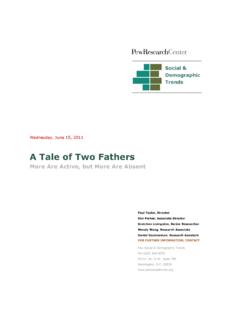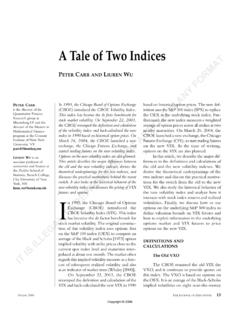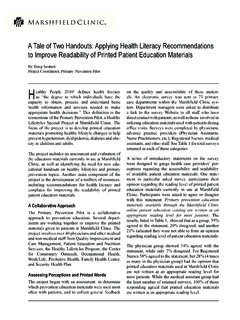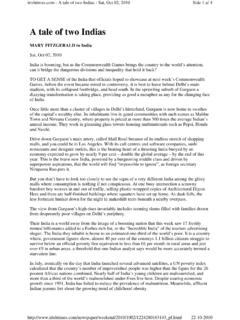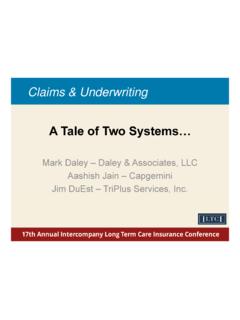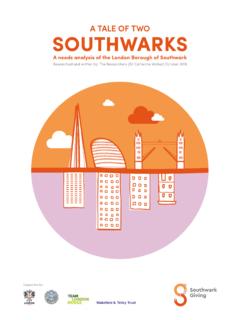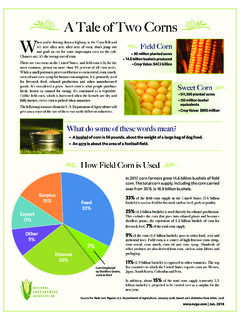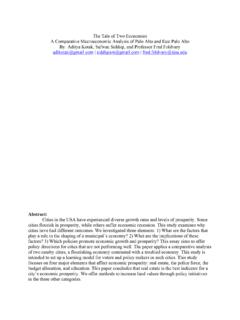Transcription of A tale of two safeties - erikhollnagel.com
1 a tale of two safeties HOLLNAGEL Erik1, 2. 1 Professor, Institute of Regional Health Research, University of Southern Denmark 2. Chief Consultant, Center for Quality, Region of Southern Denmark, P. V. Tuxens Vej 5, DK-5500 Middelfart, Denmark Abstract: The sustained existence of modern societies depends on the safe and efficient functioning of multiple systems, functions, and specialised services. Because these often are tightly coupled, safety cannot be managed simply by responding whenever something goes wrong. Both theory and practice make clear that safety management that follows developments rather than leads them runs a significant risk of lagging behind and of becoming reduced to uncoordinated and fragmentary fire-fighting. (The same, of course, goes for the management of quality and productivity.) In order to prevent this from happening, safety management must look ahead, not only to avoid that things go wrong but also and more importantly to ensure that they go right.
2 Proactive safety management must focus on how everyday performance usually goes well rather than on why it occasionally fails, and must actively try to improve the former rather than simply prevent the latter. Keyword: Safety-I; safety-II; resilience engineering; performance variability; successes 1 Safety as the freedom from industrial revolution, around 1750, which was marked by the invention of a usable steam engine. unacceptable risk1. The rapid mechanisation of work that followed led to Safety has traditionally been defined as a condition a growing number of hitherto unknown types of where nothing goes wrong. Or rather, since we know accidents, where the common factor was the that it is impossible to ensure that nothing goes breakdown, failure, or malfunctioning of active wrong, as a condition where the number of things technology. Andrew Hale and Jan Hovden[1] have that go wrong is acceptably small (See in the part of characterised this as the age of technology, in which Appendix, *1).
3 This is, however, an indirect and safety concerns focused on guarding machinery, somewhat paradoxical definition since safety is stopping explosions and preventing structures from defined by its opposite, by what happens when it is collapsing. The focus on technology as the main or missing. As a consequence of this definition, safety is even only source of both problems and solutions in also measured indirectly, not by its presence or as a safety was successfully maintained until 1979, when quality in itself, but by the consequences of its the accident at the Three Mile Island nuclear power absence. plant demonstrated that safeguarding technology was In relation to human activity it makes good practical not enough (See in the part of Appendix, *2). The sense to focus on situations where things go wrong, TMI accident brought to the fore the role of human both because such situations by definition are factors or even of the human factor and made it unexpected and because they may lead to unintended necessary to consider human failure and and unwanted harm or loss of life and property.
4 An malfunctioning as a potential risk. Seven years later early example is the collapse of the Rialto Bridge in the loss of the space shuttle Challenger, reinforced by Venice, when it became overloaded with spectators at the accident in Chernobyl, required yet another the wedding of the Marquess of Ferrara in 1444. extension, this time by adding the influence of (Many spectacular accidents have, of course, organisational failures and safety culture to the happened before that, but the historical record is common lore. sketchy and incomplete.) The bridge collapse is characteristic of the classical safety concerns, which Throughout the ages, the starting point for safety addressed risks related to passive technology and concerns has been the occurrence, potential or actual, structures such as buildings, bridges, ships, etc. This of some kind of adverse outcome, whether it has been concern was reinforced by the needs of the second categorised as a risk, a hazard, a near miss, an Received date: February 28, 2013.
5 Incident, or an accident. Historically speaking, new Nuclear Safety and Simulation, Vol. 4, Number 1, March 2013 1. HOLLNAGEL Erik types of accidents have been accounted for by 149). Reduced attention is precisely what happens introducing new types of causes ( , metal fatigue, when actions regularly produce the intended and human error', organisational failure) rather than by expected results and when things simply' work. challenging or changing the basic underlying When things go right there is first of all no difference assumption of causality. We have therefore through between the expected and the actual, hence nothing centuries become so accustomed to explaining that attracts attention or initiates an arousal reaction. accidents in terms of cause-effect relations simple Neither is there any motivation to try to understand or compound that we no longer notice it. And we why things went well: they obviously went well cling tenaciously to this tradition, although it has because the system people and technology worked becomes increasingly difficult to reconcile with as it should and because nothing untoward happened.
6 Reality. While the first argument the lack of a noticeable difference between outcomes is acceptable, the Habituation second argument is fatally flawed. The reason for that An unintended but unavoidable consequence of will become clear in the following. associating safety with things that go wrong is a creeping lack of attention to things that go right. The 2. Looking at what goes wrong rather psychological explanation for that is called than looking at what goes right habituation, a form of adaptive behaviour that can be described as non-associative learning. Through To illustrate the consequences of looking at what goes habituation we learn to disregard things that happen wrong rather than looking at what goes right, consider regularly, simply because they happen regularly. The Fig. 1. This represents the case where the (statistical). formal definition of habituation is a response probability of a failure is 1 out of 10,000 technically decrement as a result of repeated stimulation [2].
7 In written as p = 10-4. This means that for every time we academic psychology, habituation has been studied at expect that something will go wrong (the thin line), the level of neuropsychology and also usually been there are 9,999 times where we should expect that explained at that level[3]. things will go right and lead to the outcome we want It is, however, entirely possible also to speak about (the grey area). The ratio of 1:10,000 corresponds to a habituation at the level of everyday human behaviour system or organisation where the emphasis is on actions and responses. This was noted as far back as performance[6]; the ratio would be even more extreme in 1890, when William James, one of the founding for an ultrasafe system. fathers of psychology, wrote that habit diminishes the As an example of this, consider the train collision in conscious attention with which our acts are Buizingen, Belgium on 15 February 2010[7]. Two performed. [4]. In today's language it means that we trains, carrying 250 300 people, collided in snowy stop paying attention to something as soon as we get conditions during the morning rush hour.
8 The trains used to doing it. After some time we neither notice that apparently collided laterally at a set of points at the which goes smoothly, nor do we think it is necessary exit of Halle station. Eighteen people were killed and to do so. This applies both to actions and their 162 injured, and there was major damage to the tracks. outcomes both what we do ourselves and what The investigation found that one of the trains had others do. passed a red signal without stopping (SPAD or Signal From an evolutionary perspective, as well as from the Passed At Danger), and that this could be a point of view of an efficiency-thoroughness contributing cause to the collision. On further trade-off[5], habituation makes a lot of sense. While investigation, it was found that there were 130 SPAD. there are good reasons to pay attention to the events in Belgium in 2012, of which one third were unexpected and the unusual, it may be a waste of time serious. But it was also estimated that there were about and effort to pay much attention to that which is cases of trains stopping at a red signal.
9 The common or similar. To quote James[4] again: Habitual probability of a SPAD was therefore 10-5, the actions are certain, and being in no danger of going probability of a serious SPAD was 10-6, and the astray from their end, need no extraneous help (p. probability of the accident was 10-8. Another example can be found in the statistics for 2 Nuclear Safety and Simulation, Vol. 4, Number 1, March 2013. a tale of two safeties Frankfurt airport. In 2011 there were a total of 490,007 encouragement. There is no demand from authorities movements, but only 10 infringements of separation and regulators to look at what works well, and if and 11 runway incursions. This corresponds to a ratio someone should want to do so there is little help to be of 10-5 and 10-5, respectively, or roughly 2 found; we have few theories or models about how cases out of every human and organisational performance succeeds, and few methods to help us study how it happens;. examples are few and far between[8], and actual data are difficult to locate; it is hard to find papers, books or other forms of scientific literature about it; and there are few people who claim expertise in this area or even consider it worthwhile.)
10 It furthermore clashes with the traditional focus on failures, and even those who find it a reasonable endeavour are at a loss when it comes to the practicalities: there are no simple methods or tools and very few good examples to learn from. Yet one interesting consequence of this perspective is The imbalance between things that go right and things that safety and core business no longer compete for that go wrong. resources; what benefits one will also benefit the other. Another consequences is that learning can focus on The tendency to focus on what goes wrong is that which has gone right, which means that there are reinforced in many ways. It is often required by literally countless opportunities for learning, and that regulators and authorities; it is supported by models data are readily available once the attention is turned and methods; it is documented in countless databases away from failures. and illustrated by almost as many graphs; it is described in literally thousands of papers, books, and 3 Safety-I: Avoiding that things go conference proceedings; and there are an untold number of experts, consultants, and companies that wrong constantly remind us of the need to avoid risks, The traditional definition of safety as a condition failures, and accidents and of how their services can where the number of adverse outcomes (accidents /.)


